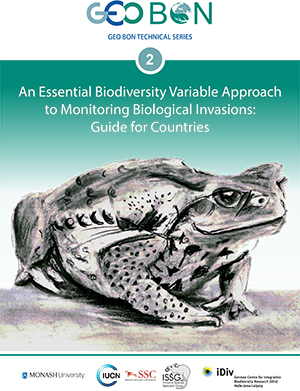Invasive alien species are well known as being a great risk to the environment and economies. However, there is currently no global, systematic evaluation and monitoring process in place for invasive alien species. Also, the variables and measures for monitoring invasions in a standardised way – needed to underpin a robust observation system – have until now not been fully developed or adopted. Here we present the Essential Biodiversity Variables for global monitoring of biological invasions.
 |
An Essential Biodiversity Variable Approach to Monitoring Biological Invasions: Guide for Countries |
The variables for invasion monitoring fit within the broader framework of Essential Biodiversity Variables (EBVs; Pereira et al., 2013). The EBV framework underpins the development of a global system of harmonized observations on biodiversity change. Similarly, essential variables for invasion monitoring underpin the development of a global system of harmonised observations to assess and track the status of biological invasion (McGeoch et al., 2006; McGeoch et al., 2010).
The key set of measurements, or essential variables that are needed to monitor biological invasions are (1) alien species occurrence, the (2) alien status of a species and the (3) impact that a species has on biodiversity and ecosystems (McGeoch et al., in review; GEO BON, 2015).
Relationship between Alien species occurrence and EBVs“Species occurrence” – including alien species occurrence – belongs to the class of Essential Biodiversity Variables called ‘Species populations’ (Pereira et al. 2013) and forms part of the ‘Species distributions’ EBV within this class. Observation data on alien species occurrence therefore contribute directly to the Species distributions EBV.
The status of a species as either alien or native at any particular locality can be considered to be an attribute of the species occurrence variable, or information that is ancillary to species occurrence. It is not itself an Essential Biodiversity Variable (EBV; Pereira et al. 2013). Nonetheless, in the context of biological invasions, this information takes on special significance. It is the essential basis upon which appropriate policy and management decisions are taken. There is also the need to prioritize collection and collation of these data, which are currently inadequate (McGeoch et al. 2012), to support effective invasion management.
The ‘alien species impact’ variable is a higher level, composite variable that includes information from multiple Essential Biodiversity Variables (EBVs), such as species traits and ecosystem structure and function. It is not itself an Essential Biodiversity Variable (EBV) (Pereira et al. 2013). Alien species impact, quantified using the standardised method for classifying alien species according to the size of their impacts can be used as an indicator of the change of ecosystems and economies by biological invasion (Hawkins et al., 2015; Blackburn et al., 2014). This variable is therefore not ‘observation’ based but rather the outcome of a semi-quantitative, analytical and stakeholder involved process.
Some of these data must be provided by countries themselves, whereas a wealth of additional supporting information is available from elsewhere to support national and global monitoring efforts (GEO BON, 2015). Together these essential variables provide the minimum information set needed to assess and track the status of biological invasion (McGeoch et al., in review; GEO BON, 2015). This will enable countries with a range of baseline data adequacies and capacities to report on the status of biological invasions and to work towards achieving Aichi Target 9 of The Convention on Biological Diversity’s Strategic Plan for Biodiversity, 2011-2020.
References:
Blackburn, T. M. et al. (2014) A unified classification of alien species based on the magnitude of their environmental impacts. PLOS Biology 12 | doi: 10.1371/journal.pbio.1001850
GEO BON (2015) An Essential Biodiversity Variable Approach to Monitoring Biological Invasions: Guide for Countries. http://www.geobon.org/downloads/biodiversity-monitoring/technical-reports/GEOBON/2015/Monitoring-Biological-Invasions.pdf
Hawkins, C.L., et al. (2015) Framework and guidelines for implementing the proposed IUCN Environmental Impact Classification for Alien Taxa (EICAT). Diversity and Distributions | doi: 10.1111/ddi.12379
McGeoch, M.A., Chown, S.L. and Kalwij, J.M. (2006) A global indicator for biological invasion. Conservation Biology 20, 1635 – 1646. | doi: 10.1111/j.1523-1739.2006.00579.x
McGeoch, M. A., Butchart, S. H. M., Spear, D., Marais, E., Kleynhans, E. J., Symes, A., Chanson, J. and Hoffman, M. (2010) Global indicators of biological invasion: species numbers, biodiversity impact and policy responses. Diversity & Distribution, 16, 95–108. | doi: 10.1111/j.1472-4642.2009.00633.x
McGeoch, M.A., Spear, D., Kleynhans, E.J. and Marais, E. (2012) Uncertainty in invasive alien species listing. Ecological Applications, 22, 959-971. | doi: 10.1890/11-1252.1
McGeoch, M. A., Pyšek, P., Jeschke, J. M., Blackburn, T. M., Bacher, S., Capinha, C., Costello, M. J., Fernández, M., Gregory, R. D., Hobern, D., Hui, C., Jetz, W., Kumschick, S., Latombe, G., Pergl, J., Roy, H. E., Scalera, R., Squires, Z. E., Wilson, J. R. U., Winter, M. and Genovesi, P. (in review) A vision for global monitoring of biological invasions.
Pereira, H.M. et al., (2013) Essential Biodiversity Variables, Science 339, 277-278 | doi: 10.1126/science.1229931
